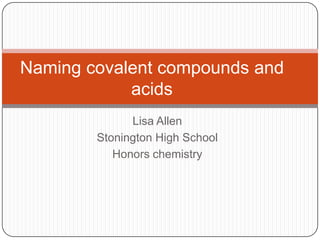
Naming covalent compounds and acids
- 1. Naming covalent compounds and acids Lisa Allen Stonington High School Honors chemistry
- 2. How do you know the compound is covalent? 1. The compound is called a molecule. Molecules are covalently bonded. 2. The compound doesn’t start with a metal or with ammonium. 3. The compound is made from elements that are similar in electronegativity 4. Organic compounds often have carbon for their first element, and that is going to form covalent bonds. These frequently use another naming system you will learn in organic chemistry!
- 3. To name covalent compounds, use prefixes 1- mono 2- di 3 – tri 4 – tetra 5 – penta 6 – hexa 7 – hepta 8 – octa 9 – nona 10 - deca
- 4. Simple rules Write the name of the less electronegative element first. If you have more than one atom of that element in the compound, you will need a prefix before its name. If not, skip the prefix here. Always put a prefix before the name of the more electronegative element. Change the ending of the second element to –ide.
- 5. Practice a few of these CO P2O5 OF2 SO2 SO3 N2O5 N2O4 H2O
- 6. Practice a few of these CO Carbon monoxide P2O5 Diphosphorus OF2 pentoxide Oxygen difluoride SO2 Sulfur dioxide SO3 Sulfur trioxide N2O5 Dinitrogen pentoxide N2O4 Dinitrogen tetroxide H2O What??
- 7. What are some of the dangers associated with DHMO? Each year, Dihydrogen Monoxide is a known causative component in many thousands of deaths and is a major contributor to millions upon millions of dollars in damage to property and the environment. Some of the known perils of Dihydrogen Monoxide are: •Death due to accidental inhalation of DHMO, even in small quantities. •Prolonged exposure to solid DHMO causes severe tissue damage. •Excessive ingestion produces a number of unpleasant though not typically life-threatening side-effects. •DHMO is a major component of acid rain. •Gaseous DHMO can cause severe burns. •Contributes to soil erosion. •Leads to corrosion and oxidation of many metals. •Contamination of electrical systems often causes short- circuits. •Exposure decreases effectiveness of automobile brakes. •Found in biopsies of pre-cancerous tumors and lesions. •Given to vicious dogs involved in recent deadly attacks. •Often associated with killer cyclones in the U.S. Midwest and elsewhere, and in hurricanes including deadly storms in Florida, New Orleans and other areas of the southeastern U.S. •Thermal variations in DHMO are a suspected contributor to the El Nino weather effect. http://www.dhmo.org/facts.html
- 8. Naming acids Acids are (almost) always compounds made from hydrogen and an anion. Hydrogen plus a halogen? hydroXXXic acid Example: HCl = hydrochloric acid Hydrogen plus a polyatomic ion that ends in –ate? XXXic acid Example: Hydrogen plus nitrate is HNO3 = nitric acid Hydrogen plus a polyatomic ion that ends in –ite? XXXous acid Example: Hydrogen plus nitrite is HNO3 = nitrous acid
- 9. How many hydrogens do you add to the anion to make the acid formula? Each H+ has a +1 charge, so add one for every negative charge. Nitric acid only needs one, since nitrate is a -1 ion. Sulfuric acid is H2SO4 since sulfate has a 2- charge.
- 10. The big conclusion? IONIC COVALENT ACIDS COMPOUNDS COMPOUNDS Hydrogen is the first Include a metal and a Made from two non- element non-metal, or metals H + halogen = hydroXic ammonium and a non- Use prefixes when acid metal naming H + ate = ic acid May include Second element always H + ite = ous acid polyatomic ions gets a prefix, even if it is No prefixes used mono- D-block cations need a Roman numeral Naming system is called “the Stock system”